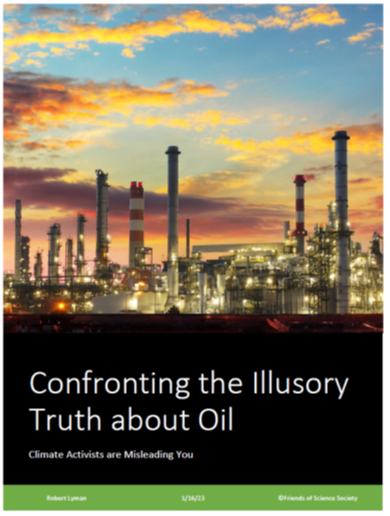CONFRONTING THE ILLUSORY TRUTH ABOUT OIL – Climate Activists are Misleading You
February 23rd 2023
EXECUTIVE SUMMARY
What psychologists refer to as “illusory truth” is the tendency of people to believe anything, regardless of how false it is, if they hear it repeated often enough. Proponents of climate alarm endlessly repeat that the people of the world are using less and less oil and that this trend is relentless and inevitable. As their logic goes, reducing and ending the production of oil is therefore a means to facilitate a trend that is happening anyway. Despite its constant repetition, it is not true.
The 2022 edition of the British Petroleum Statistical Review of World Energy provides the data on demand, by country, region and world, for crude oil and for the broader category of “crude oil and liquids”. Crude oil and liquids includes both crude oil and certain natural gas liquids such as condensate that can serve as substitutes for crude oil for some purposes. According to the review:
Over the period 2011 to 2019, total demand rose by 11.2 million barrels per day, from 89.3 million barrels per day to 100.6 million barrels per day, or just over one million barrels per day per year. This is the fastest growth in oil and liquids demand over a comparable period in history.
The economic effect of the global pandemic starting in 2020 was significant. Oil and liquids demand declined in one year by 9.2 million barrels per day.
The recovery from the pandemic effects has been almost as sharp. From 2020 to 2021, global oil and liquids demand increased by 5.5 million barrels per day, the largest one-year rise by far in history.
The data for 2022 are not yet available, but reports by the US Energy Information Administration indicate that global oil and liquids demand will exceed 99 million barrels per day. In other words, global oil and liquids demand has resumed its pre-pandemic trend of large annual increases.
Climate alarmists would have us believe that the past is not a guide to the longer-term future but rather that consumption trends can be managed by governments (though regulations, taxes and subsidies) so as completely to alter the direction of consumption trends, turning up into down. They and the organizations that promote their cause delight in publishing scenarios of the future labeled “clean and sustainable”. They should be labelled “unlikely or unfeasible”.
The projections of the United States Energy Information Administration (EIA) and of the Organization of Petroleum Exporting Countries (OPEC) are that oil demand will increase steadily to the end of their projection periods (at least 2045).
The much-increased oil and liquids demand must be met by production and that can be in the OPEC countries or elsewhere, including North America. Policies that seek to limit investment in oil production may make the available supplies more expensive and they may hinder the economic development of some countries, like Canada, but they will not stop the global trends. It is time to confront the illusory truth about oil for the sham that it is.
View Plan [PDF]
Credits to Friends of Science
blog.friendsofscience

Click to close
